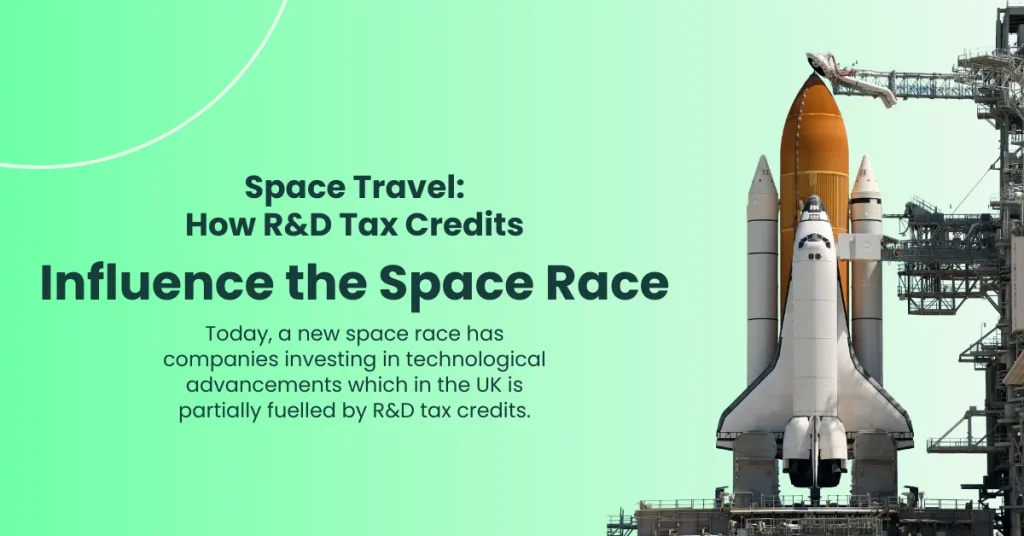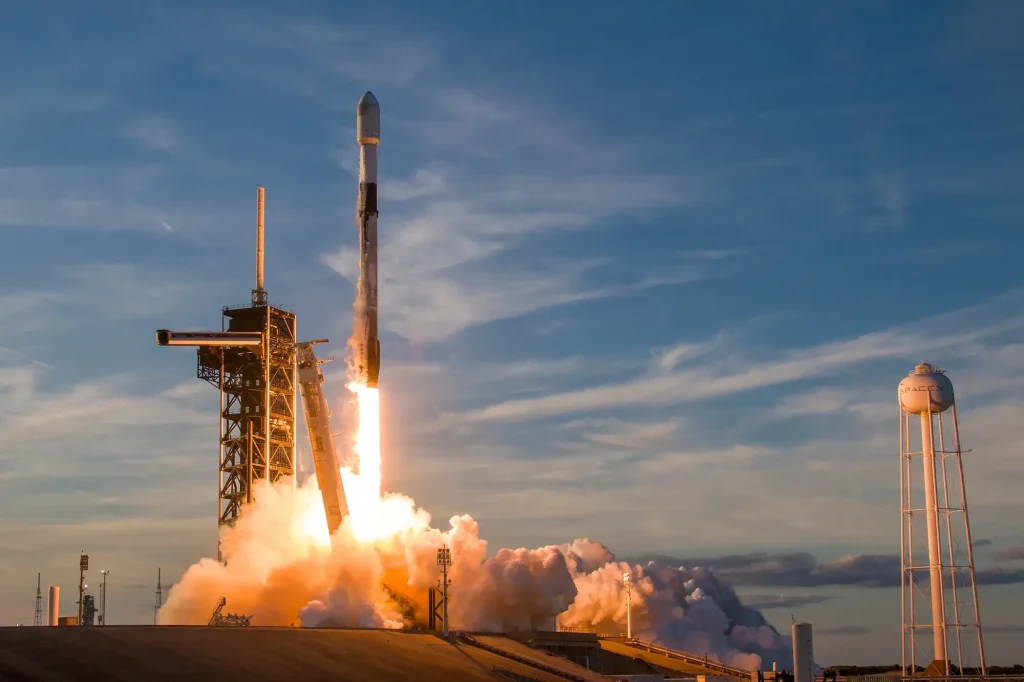Space Travel: How R&D Tax Credits Influence the Space Race

In the 20th century, innovative research and development allowed humans to head for the stars. Today, a new space race has companies investing in technological advancements which in the UK is partially fuelled by R&D tax credits. Examine the history of space travel, how 21st century technology is fueling new competition, the impact of the R&D tax incentive, and how this government fund is already changing the course of space exploration.
The commercialisation of space travel has fueled a new race for advancement that encourages companies to embrace R&D tax credits incentives. This relief ensures that those participating in the 21st century space race have the ability to offset some of the financial risk, and monetarily reinvest in space related advancements.
Considering the expansive opportunities surrounding space travel and the R&D tax credits initiative, today we’re taking you on a journey of exploration through space travel innovation and this government funded incentive that guides research and development in the UK.
The History of Space Travel Innovation
With innovation and intelligence collaborating throughout the hyper competitive environment of the Cold War, the mid 20th century presented an array of scientific and technological advancements that led to these pivotal moments in the history of space travel:
- First unmanned spacecraft launch (1957)
The Soviet Union’s launch of an artificial satellite named Sputnik 1, sparked the beginning of the Space Race with the United States - First manned spaceflight (1961)
The flight of Yuri Gagarin aboard Vostok 1 marked humanity’s first foray into space - First man on the moon (1969)
Neil Armstrong’s famous words: “That’s one small step for man, one giant leap for mankind” echoed the successful landing of humans on the moon as he disembarked from Apollo 11 - First reusable spacecraft (1981)
The launch of STS-1 Columbia launched what’s known as the Shuttle Era, which saw 135 missions throughout its 30 year existence
While these monumental moments have led to innovations that now allow long term stays in the upper orbits of the Earth’s atmosphere about the International Space Station (ISS), there have of course been complications along the way – some of which leading to tragedies like the Challenger Disaster.
Space Travel in the 21st Century
Initiating a new era of space exploration, the 21st century has witnessed a dynamic shift in how we reach for the stars. Private companies like SpaceX and Virgin Galactic have played an essential role in driving innovation by:
- Developing more sustainable reusable spacecraft
- Reducing the cost of space travel
- Increasing access to outer space
By investing in advancements in artificial intelligence (AI) and robotics have enabled autonomous spacecraft operations, a new space race has been sparked within the private sector, with companies competing to achieve milestones such as commercial space tourism and even the colonisation of other planets.

Falcon 9 lift off from Kennedy Space Center. Image courtesy of SpaceX.
The Economics of Space Travel
As private companies propel the prospects of space travel, understanding the financial aspects of venturing beyond our planet is essential for the sustainability and growth of space missions.
Delving into the economics of space travel, some of the largest financial impacts come as a result of:
- Launch operation costs
- Manufacturing and production costs
- Talent acquisition and retention
- Research and development investment
Given the extent of costs associated with space travel, even large businesses require a range of additional financial resources in order to achieve the impossible. This is where companies invested in space exploration can receive financial support in the form of government funding.
The Importance of Government Funding in Space Travel
While government agencies such as NASA are fully reliant on government funding, private sector companies have the ability to benefit from investment opportunities as well as government provided funds.
In the UK there are a number of government initiatives that support private companies with space exploration advancement projects. Some of the key funding opportunities are as follows:
- UK Space Agency grants
- European Space Agency (ESA) funding programmes
- R&D tax credits
These funds enable the development of cutting edge technologies, the construction of advanced spacecraft, and the implementation of complex missions that would be unattainable through private investment alone.
How R&D Tax Credits Support Space Travel Innovation
R&D tax credits play a significant role in driving innovation in the space travel industry by providing financial incentives for companies investing in research and development activities. Here are some key ways in which R&D tax credits support space travel innovation:
- Risk mitigation for experimental projects
- Supporting long term innovation strategies and projects
- Promoting technological innovation
- Encouraging collaboration with research institutions
With their additional ability to enhance cash flow for further investment, R&D tax credits have the potential to stimulate economic growth throughout the space sector.
Book a quick call back
Qualifying R&D Projects and Activities in Space Travel
Given the fact that HMRC defines R&D as a project that seeks to overcome a scientific or technological uncertainty that cannot be solved by an individual expert in the field, qualifying R&D projects in space travel encompass a wide array of endeavours.
These projects may often involve activities such as:
- Development of cutting edge propulsion systems
- Advanced materials for spacecraft construction
- Navigation and communication technologies
- Enhanced astronaut safety
- Improvement of life support systems
- Optimised mission planning
These projects aim to expand our understanding of celestial bodies and pave the way for future manned missions beyond Earth’s orbit. Overall, the area of qualifying R&D projects and activities in space travel is vast and essential for driving innovation in the field of space exploration.
Innovations in Space Exploration Driven by R&D Tax Credits
R&D tax credits have spurred advancements in various areas of space exploration, leading to groundbreaking developments that propel humanity’s understanding and presence in space.
The following are a few examples of how R&D tax credits inspired innovation in space exploration
- Advanced satellite systems
The development of cost effective satellites used for Earth observation, communications and scientific research - Space based quantum technologies
The advancement of space based quantum communication systems that enhance cybersecurity for satellite data transmission - Spacecraft propulsion systems
Development of advanced propulsion technologies like the SABRE engine - Earth observation data platforms
Creation platforms that analyse Earth observation data from satellites that aid in climate monitoring, disaster response and agriculture - Space debris removal technology
Development of technology for the removal of space debris, a critical innovation for sustainable space exploration
Frequently Asked Questions
Considering the vast research and development opportunities available within space exploration, the scope of R&D tax credits can be seemingly endless. So that we can ensure that you’re equipped with all the relevant information, we’re answering some of the most frequently asked questions in relation to space travel.
Are R&D Tax Credits Available to All Companies Involved in Space Exploration?
The main requirement is that the claiming company is liable to corporation tax in the UK. As long as the company fits this criteria, they may claim their qualifying R&D expenditure.
Can R&D Tax Credits Be Used for International Collaborations in Space Innovation?
Absolutely, R&D tax credits can typically be utilised for international collaborations in space innovation. It’s a fantastic way to foster global partnerships and drive advancements in space travel.
How Do R&D Tax Credits Impact the Competitiveness of Space Travel Companies?
When R&D tax credits support space travel companies, we all benefit. They boost competitiveness by fostering innovation, driving progress in technology that may then be used for other Earth based purposes. What’s more is that these credits lay the foundation for exploration, enabling companies to push boundaries and reach new heights.
Final Thoughts
In summary, R&D tax relief plays an essential role in driving innovation in space travel. By providing financial incentives for companies to invest in cutting edge projects, these credits pave the way for advancements in technology and exploration beyond our planet.
From the historical achievements of the past to the exciting possibilities of the future, R&D tax credits continue to support and propel the dreams of reaching new frontiers in the area of space exploration.
How Alexander Clifford Can Help
With expert insights into HMRC policy, our team of specialists are dedicated to helping innovative companies seek R&D tax relief.
This dedication has so far allowed our R&D tax credit specialist consultants to compile and submit over 2,400 claims that resulted in an average relief of over £50,000.
That’s what makes Alexander Clifford your trusted choice for R&D tax credits.
Unearth the measure of your space travel project and what R&D tax relief can do for you, by chatting with one of our specialists today. Simply fill in the form below and we’ll give you a call.
Get a decision on your R&D eligibility from a qualified specialist in 15 minutes.







